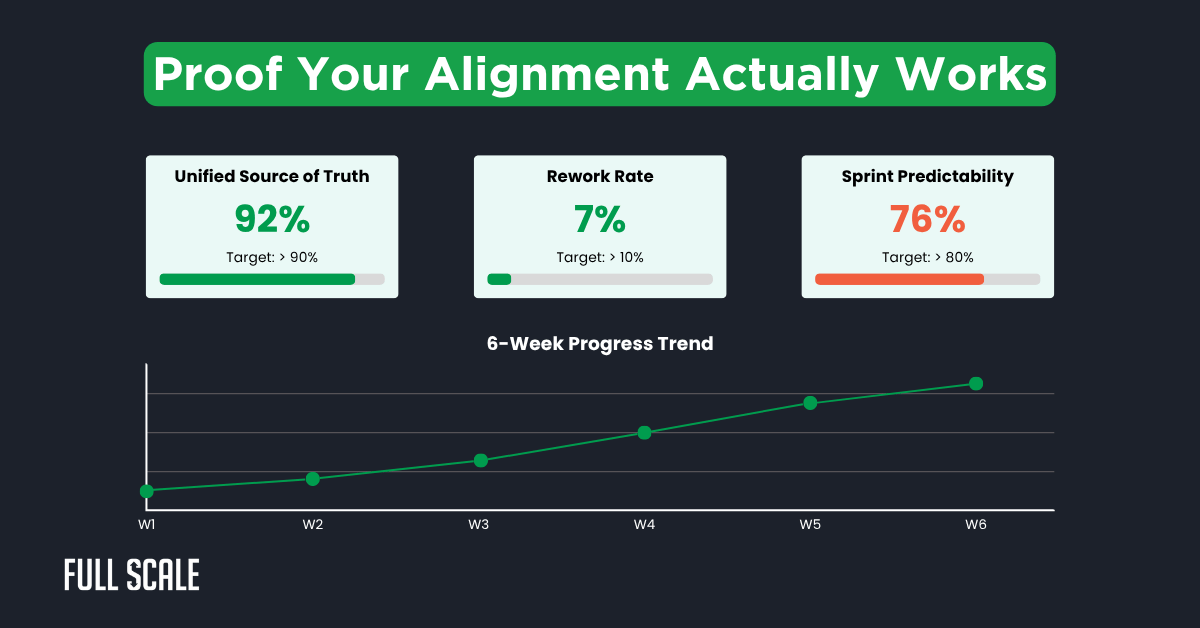Last Updated on 2025-08-28
Product engineering collaboration for remote teams isn’t just another buzzword—it’s the difference between shipping features and shipping disasters. Last year, a single misunderstood Slack message cost us and our client three months of development time and $300,000 in wasted effort.
Here’s what happened: Our product manager wrote “dashboard for user metrics.” The engineering team built a complex analytics platform. What did the client actually want? A simple KPI display that should’ve taken two weeks.
This is why product engineering collaboration for remote teams can’t be left to chance.
Look, 73% of distributed teams screw this up, according to GitLab’s 2024 Remote Work Report. But yours doesn’t have to join that club of expensive failures.
What Is Product Engineering Collaboration for Remote Teams?
Product engineering collaboration for remote teams is a systematic approach to aligning product vision with technical execution across distributed teams. It uses structured communication protocols, shared documentation, and continuous feedback loops to prevent feature drift and wasted development cycles.
Think of it as the operating system for your distributed product development process. Without it, you’re basically playing telephone across time zones and hoping for the best.
The truth is, product engineering collaboration for remote teams requires more than good intentions. It needs a system.

This framework transforms chaotic distributed development into predictable delivery. Let me show you exactly how to implement product engineering collaboration for remote teams without the usual corporate BS.
Every week without proper product engineering collaboration for remote teams is another week closer to your own $300k mistake.
The Four Pillars of Remote Product Engineering Alignment
Your distributed team is probably held together by duct tape and good intentions right now. These four pillars will actually fix that.
Pillar 1: Unified Source of Truth (Or: Stop Playing “Version Roulette”)
Multiple versions of requirements kill remote team productivity. Atlassian found that 60% of distributed teams waste 5+ hours weekly searching for the right documentation. That’s 260 hours a year of pure waste—congrats, you just burned three developer salaries.
Here’s the thing: Your source of truth isn’t just a repository—it’s your team’s north star. And most companies get this completely wrong.
Product engineering collaboration for remote teams becomes a guessing game without a proper source of truth. An expensive one.
Choose One System (Not Five)
Pick your primary platform and stick to it. I don’t care if it’s Jira, Notion, or a shared Google Doc written in crayon. The tool doesn’t matter—having everyone actually use the same tool does.
Define Decision Ownership (Because Democracy Doesn’t Ship Features)
Every requirement needs an owner. Not a committee, not “the team”—one person who makes the call. Create a simple matrix showing who decides what, so your product engineering collaboration for remote teams doesn’t devolve into endless Slack debates.
Source of Truth Setup Checklist
Source of Truth Setup Checklist
Source of Truth Setup Checklist
Click each item as you complete it (or live in chaos forever)
This interactive checklist helps you track your progress in setting up your source of truth. Each item represents a critical step that prevents the "which version is right?" chaos that burns budgets.
Remember: Product engineering collaboration for remote teams starts with everyone looking at the same information. Otherwise, you're just gambling with development time.
Pillar 2: Structured Communication Cadence (Or: How to Talk Without Talking Past Each Other)
Time zones don't have to destroy your remote team alignment strategies. You just need a communication rhythm that works asynchronously first, synchronously second. Most companies get this backwards and wonder why their offshore team seems "disconnected."
The Full Scale protocol has reduced miscommunication by 80% across our distributed teams.
Here's the exact schedule that makes product engineering collaboration for remote teams actually work:
Daily: Async Standups (5 minutes)
Post updates before your local EOD. Include what you shipped, what's blocking you, and any assumptions you're making. If you can't explain it in 5 minutes, you don't understand it well enough.
Weekly: Product-Engineering Sync (30 minutes)
Rotate meeting times quarterly to share timezone burden. Always record for those who can't attend. If someone misses the recording, too, that's on them.
Sprint: Kickoff and Review Rituals (1 hour each)
Never start work without alignment. These meetings pay for themselves by preventing rework. I've seen teams skip these to "save time" and then spend three weeks building the wrong thing.
| Meeting Type | Frequency | Duration | Key Outcome | What Happens If You Skip It |
| Async Standup | Daily | 5 min | Blocker visibility | Surprises on Friday |
| Product-Eng Sync | Weekly | 30 min | Priority alignment | Building yesterday's priorities |
| Sprint Kickoff | Bi-weekly | 60 min | Requirement clarity | The $300k mistake |
| Sprint Review | Bi-weekly | 60 min | Delivery validation | "That's not what we wanted" |
| Strategic Alignment | Monthly | 90 min | Roadmap sync | Different teams, different products |
Your meeting structure determines your team's success. Too many meetings kill productivity; too few create drift. This balance took us years to figure out—steal it.
Product engineering collaboration for remote teams thrives on predictable communication patterns. Create them, stick to them, watch magic happen.
But here's the kicker: Without proper product engineering collaboration for remote teams, even the best meeting cadence falls apart. You need all four pillars working together.
Pillar 3: Context-Rich Documentation (Or: Write Like Your Job Depends on It)
Build a dashboard" means nothing without context. I've watched teams interpret this as everything from a simple chart to a full BI platform. Our distributed team product development process requires documentation that leaves zero room for interpretation.
Here's what changed everything for us: We stopped writing requirements and started creating experiences. Every feature now includes business context, visual mockups, and clear success metrics. Revolutionary, right?
The reality is that product engineering collaboration for remote teams depends on documentation quality. Bad documents equal bad builds.
The User Story That Actually Works
Forget the textbook "As a user, I want..." format. That's corporate theater. Here's what distributed development frameworks actually need:
- Business Context First: Start with why this matters to the business. Engineers make better decisions when they understand impact. "This will reduce churn by 15%" beats "stakeholders want this" every time.
- Visual Requirements Always: A mockup prevents a thousand clarifying messages. Use screenshots, sketches, or Loom videos. I don't care if you draw it on a napkin—just show what you mean.
- Success Metrics Upfront: Define what "done" looks like with numbers. Vague acceptance criteria waste sprints. "Page loads in under 2 seconds" is testable. "Fast performance" is worthless.
The Hidden Cost of Bad Documentation
Poor documentation in product engineering collaboration for remote teams doesn't just slow you down—it compounds. One vague requirement becomes three clarifying meetings, which becomes a week of wrong work, which becomes a missed deadline. Do the math on your hourly rate. Painful, isn't it?
The Only Documentation Template You'll Actually Use
Context-Rich Documentation Template
The Only Documentation Template You'll Actually Use
This template generator creates documentation that engineers actually understand. Fill it out once, eliminate dozens of clarifying conversations, and stop playing requirement roulette.
Most importantly, it makes product engineering collaboration for remote teams actually possible. Without clear docs, you're just hoping developers read minds.
Pillar 4: Continuous Alignment Checkpoints (Or: Catch Problems Before They Cost Millions)
Waiting until the sprint review to discover misalignment is like finding out your GPS was wrong at your destination. Expensive and stupid. You need checkpoints throughout the journey.
The 48-Hour Gut Check
Within 48 hours of starting any feature, developers demo their understanding. This isn't about code—it's about confirming interpretation before investing days of work. We've caught multi-week mistakes in 10-minute demos.
Mid-Sprint Alignment Reviews
Halfway through each sprint, product and engineering sync on progress. Catching drift here saves the back half of your sprint. It's like a safety net for your product engineering collaboration for remote teams.
Pre-Release Validation
Before any deployment, validate that what's built matches what was intended. This final check prevents the expensive "that's not what we meant" conversation that makes everyone look bad.
Why Most Teams Skip Checkpoints (And Regret It)
"We don't have time for all these meetings." Sure, but do you have time to rebuild features three times? The math doesn't work. These checkpoints take 2-3 hours per sprint total. Misalignment costs weeks.
Product engineering collaboration for remote teams isn't about more meetings—it's about the right meetings at the right time.
Implementation Roadmap for Product Engineering Collaboration for Remote Teams
Getting your remote engineering team communication aligned doesn't happen overnight. But it doesn't take six months either.
Here's your six-week roadmap to transformation:
The key to successful product engineering collaboration for remote teams?
Start small, measure everything, and don't skip steps.
Weeks 1-2: Foundation Building (The "Stop the Bleeding" Phase)
Start with your source of truth. Pick your platform, migrate your requirements, and get everyone access. This is where most teams overthink and underdeliver.
Don't overthink the tool choice—pick one and commit. I've seen teams spend three months evaluating tools while their projects burn. The process matters more than the platform.
Product engineering collaboration for remote teams succeeds with mediocre tools and great processes. It fails with great tools and mediocre processes.
Weeks 3-4: Process Implementation (The "New Habits" Phase)
Roll out your communication cadence gradually. Start with async standups, then add weekly syncs. Force the habit before adding complexity.
Train your team on the documentation template. Make the first few examples together to set the standard. When someone says "but we've always done it differently," remind them how well that's been working.
Remember: Product engineering collaboration for remote teams lives and dies by how well you execute these first four weeks. Nail this, and the rest follows.
Weeks 5-6: Optimization and Measurement (The "Prove It Works" Phase)
Run your first complete cycle with all checkpoints. Gather feedback after each meeting type. Some will complain—that's normal. Change is hard.
Track these metrics to prove your product engineering collaboration for remote teams is working:
- Feature acceptance rate (target: >90%)
- Rework percentage (target: <10%)
- Sprint predictability (target: 80% completion)
- Developer sanity (target: not quitting)

This dashboard shows what success looks like after implementing the framework. Notice how alignment issues decrease dramatically after week three—that's when the process clicks and people stop fighting it.
The metrics prove what we already know: Product engineering collaboration for remote teams works when you commit to the system.
5 Common Pitfalls in Remote Team Product Development (And How Not to Be an Idiot)
Even with the best framework, teams stumble on predictable problems. Here's how to avoid looking like amateurs:
1. Over-Documentation Syndrome
Perfect documentation that ships next quarter is worthless. Aim for 80% clarity that ships this week. Your offshore team product management doesn't need a novel—they need clarity.
2. Meeting Overload
More meetings don't equal better alignment. Stick to the cadence religiously—resist adding "quick syncs" that destroy deep work. Every additional meeting is a developer not coding.
3. Tool Obsession
Teams waste months evaluating tools instead of improving processes. Your current stack probably works fine with better processes. I've seen million-dollar tools fail because of ten-cent processes.
Here's the truth: Product engineering collaboration for remote teams isn't a technology problem. It's a process problem.
4. Cultural Assumptions
"I thought you understood." kills global teams. Always verify understanding explicitly, especially across cultural boundaries. What's obvious in Austin might be ambiguous in Bangalore.
5. The "We're Different" Excuse
Every team thinks they're special, and these rules don't apply. They're wrong. Physics doesn't change because your startup is "disruptive." Neither do communication principles.
The fundamentals of product engineering collaboration for remote teams apply whether you're building rockets or recipe apps. Stop making excuses.
The ROI of Product Engineering Alignment
McKinsey's 2024 Developer Productivity Report shows aligned teams ship 2.3x faster than misaligned ones. But honestly, that's conservative. The real wins go beyond velocity.
When Full Scale implemented this framework across our 200+ developer teams, we saw:
- 80% reduction in feature rework (that's real money)
- 60% faster time-to-market for new features
- 95% developer satisfaction scores (up from 72%)
- 100% fewer "emergency" weekend rebuilds
The cost of misalignment compounds over time. One misunderstood feature becomes a missed market opportunity, which becomes a competitor's advantage. Do the math on that.
Bottom line: Product engineering collaboration for remote teams pays for itself in the first month. Everything after that is profit.
Making Cross-Functional Team Alignment Remote Work (Without Losing Your Mind)
Your distributed team doesn't need more tools or meetings. They need clarity, consistency, and checkpoints that catch problems early. This isn't rocket science—it's discipline.
Start with one team and one sprint. Implement the source of truth first, then layer in the communication cadence. Don't try to boil the ocean.
Most importantly, measure everything. You can't improve what you don't track. And you can't justify the process without data. Numbers don't lie—opinions do.
Successful product engineering collaboration for remote teams requires metrics, not feelings. Track everything that matters.
The Uncomfortable Truth About Remote Alignment
Here's what nobody tells you: Product engineering collaboration for remote teams is harder than co-located teams. Period. Anyone who says otherwise is selling something. But harder doesn't mean impossible—it just means you need better systems.
The companies winning at distributed development aren't smarter. They're not using secret tools. They just committed to a process and stuck with it long enough to see results.
That's the secret to product engineering collaboration for remote teams: consistency beats brilliance every time.
Fix Your Product-Engineering Alignment Today
Misalignment between product and engineering isn't just frustrating—it's expensive. Every day of confusion costs you market opportunity and developer morale. But you already know that, or you wouldn't have read this far.
If you're tired of features drifting from vision to reality, let's talk.
Here's what makes Full Scale different from every other offshore shop promising "seamless collaboration":
- We've been in your shoes—Our founders built and scaled tech companies. We know the pain of miscommunication because we lived it.
- 200+ aligned developers—Not contractors, not freelancers. Full-time developers who've mastered our alignment framework.
- The 48-hour rule works—Our checkpoint system catches misalignment before it costs you sprints (and sanity).
- Direct integration, no middlemen—Your developers join YOUR standups, YOUR Slack, YOUR workflow. No telephone game.
- 95% developer retention—Because aligned teams are happy teams. Happy teams ship better code.
- 60+ companies trust our process—From seed-stage startups to Series C scale-ups. Different industries, same results.
Our developers don't just code—they collaborate. Our process doesn't just work—it scales. And unlike your current approach, it's been battle-tested across millions of lines of production code.
We're not just another offshore shop. We're the company that solved product engineering collaboration for remote teams.
Let’s Stop Feature Drift and Start Shipping as Planned
FAQs: Product Engineering Collaboration for Remote Teams
How long does it take to implement product engineering collaboration for remote teams?
Six weeks for full implementation, but you'll see improvements within the first sprint. Week one stops the bleeding, week three shows progress, and week six proves the ROI. Most teams try to rush this and end up taking twice as long. Slow down to speed up.
What tools do you recommend for distributed team product development?
The tool doesn't matter as much as everyone using the same tool. We've seen teams succeed with Jira, Linear, Notion, even Trello. Pick one, commit, and stop tool-shopping. Your problems aren't technical—they're procedural. That said, avoid tools that don't support async collaboration or version history.
How do you handle time zone differences in product engineering collaboration for remote teams?
Async-first, sync-second. Document everything, rotate meeting times quarterly, and record every sync session. Use the "two-timezone rule"—optimize for no more than two major timezone groups per team. If someone has to take a 3 AM call regularly, your structure is broken.
What's the biggest mistake companies make with remote team alignment strategies?
Thinking more meetings equals better alignment. Wrong. The biggest mistake is having unclear documentation and hoping meetings will fix it. The second biggest? Not establishing a single source of truth. The third? Assuming everyone interprets requirements the same way. See the pattern? It's all about clarity, not face time.
What's the best team size for product engineering collaboration for remote teams?
Keep teams between 5-9 people for optimal collaboration. Larger teams create communication overhead that kills productivity. If you need more developers, create multiple small teams with clear boundaries. We've tested this across hundreds of projects—smaller teams with better product engineering collaboration for remote teams beat large teams every time.

Matt Watson is a serial tech entrepreneur who has started four companies and had a nine-figure exit. He was the founder and CTO of VinSolutions, the #1 CRM software used in today’s automotive industry. He has over twenty years of experience working as a tech CTO and building cutting-edge SaaS solutions.
As the CEO of Full Scale, he has helped over 100 tech companies build their software services and development teams. Full Scale specializes in helping tech companies grow by augmenting their in-house teams with software development talent from the Philippines.
Matt hosts Startup Hustle, a top podcast about entrepreneurship with over 6 million downloads. He has a wealth of knowledge about startups and business from his personal experience and from interviewing hundreds of other entrepreneurs.




